CHAPTER: CUBAN MIGRATION, by Jefferson B. Browne, 1912
 A history of Key West which does not speak of the several revolutionary movements in Cuba, with which Key West was so closely connected, would fail in its purpose of faithfully portraying the events which have shaped or affected its destiny.
A history of Key West which does not speak of the several revolutionary movements in Cuba, with which Key West was so closely connected, would fail in its purpose of faithfully portraying the events which have shaped or affected its destiny.
In 1843 Narcisso Lopez, formerly a colonel in the Royal Spanish army, went to Cuba with Captain General Valdez. There he saw the oppression of the Cubans and his sympathies were aroused. He was suspected of conspiring against the Spanish government, and came under the surveillance of Captain General O’Donnell, the successor of Valdez, and fled to the United States in 1849. His story of Cuba’s oppression raised many sympathizers for the cause, and he found no trouble in recruiting a force of adventurous spirits to join him in an expedition having for its purpose the liberation of Cuba.
His first attempt at invasion, early in 1849, was checked by President Taylor, and the whole expedition captured as it was on the point of departure.
In May, 1850, he organized another expedition, one detachment of which, under the command of Colonel Theodore O’Hara, who wrote “The Bivouac of the Dead,” made a rendezvous on the island of Contoy, where they were joined by Lopez on the steamer Creole with four hundred and fifty followers. Matanzas was their destination, but learning that the Spaniards had been advised of their movements, they decided to land at Cardenas. On landing, Major John T. Pickett, with fifty Kentuckians, marched through the city and seized the station of the railroad that connected Cardenas with Matanzas. After a few hours fighting, in which Colonel O’Hara was wounded, the Spanish garrison surrendered and Cardenas was taken. Lopez issued a strong appeal for Cuban followers, but received no response. As he could accomplish nothing without the cooperation of the Cubans he was forced to abandon Cardenas and re-embark, which he finally succeeded in doing after some sharp fighting.
In the meantime the Spaniards had sent the gunboat Pizarro to capture the Creole, and one beautiful May morning the news spread among the citizens of the quiet little town of Key West, that was always alert at daybreak for anything unusual on the water, that the Creole was being chased by a Spanish gunboat, and was in imminent danger of being captured. The people thronged to the wharves and cupolas with which the town was then abundantly supplied (being used as lookouts from which to discover vessels stranded on the reefs).
The Creole was crowding on all steam to reach Key West, and not far behind was the Pizarro belching volumes of smoke, and rapidly closing in on her prey. As the pursued steamer aproached Fort Taylor, it was seen that her speed was slackening. A few moments more the guns of the Pizarro would open on the Creole and its gallant band of liberators. Just then black smoke was seen coming from the funnel of the Creole and her wheels revolved rapidly. They had broken open boxes of bacon and were feeding her with this, and parts of the woodwork of the vessel. The Creole maintained her lead, rounded Fort Taylor, and dashed up the harbor to F. A. Browne’s wharf (now the Martin Wagner Wharf), where the expedition landed.
The Pizarro without saluting the fort, came on behind her, and “slowed down a few yards away, with port holes open, and broadsides grinning, like the fangs of a bloodhound balked of his prey.”
In this expedition Lopez lost fourteen killed and thirty Wounded, among whom was the chaplain. The Spaniards had one hundred killed and as many wounded. Lopez was arrested by the United States authorities, and tried for violation of the neutrality law, and acquitted.
He and his party were lionized in Key West. All the best homes were thrown open to them, and they were feted as heroes. He presented to Hon. Joseph Beverly Browne the sword he had worn in the fight at Cardenas.
Their first night at Key West was marked by wild scenes of disorder. Threats were made by some of the more unruly against the Spaniards living here. The saloon of Francisco Cintas on Duval street, and the grocery store of Mr. Arnau on Whitehead street, were broken into and looted and their stocks thrown into the streets. The old Spanish citizens wisely kept within doors, until Lopez and his captains got the mob under control, which they succeeded in doing about daybreak.
In August, 1851, Lopez landed another expedition at Bahia Honda, and with his little band of two hundred and twenty three men repulsed a force of thirteen hundred Spaniards, and killed their commander, General Enna.
Cuba, however, was not ripe for revolt, and no recruits came to him. His forces gradually dwindled away and he was captured and carried to Havana, where fifty of his followers were shot, and he was garroted on September 1, 1851.
Colonel W. S. Crittenden, who had served in the Mexican War as an officer of the United States army, was sentenced to be shot, and when commanded to kneel in the customary attitude with his back to the firing party, replied : “A Kentuckian kneels only to his God,” and met death facing his executioners.
